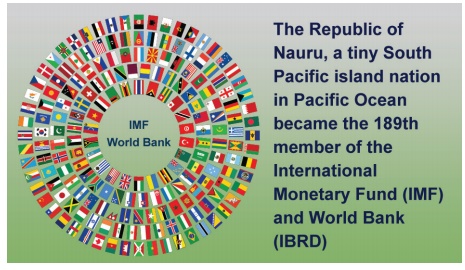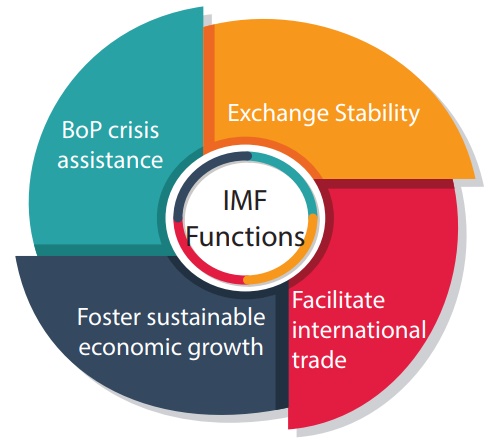International Economic Organisations - International Monetary Fund | 12th Economics : Chapter 8 : International Economic Organisations
Chapter: 12th Economics : Chapter 8 : International Economic Organisations
International Monetary Fund
International Monetary Fund
The purpose of International Monetary Fund is to secure and
promote economic and financial cooperation among member countries. The IMF was
established to assist the member nations to tide over the Balance of Payments
disequilibrium in the short term. At present, the IMF has 189 member countries
with Republic of Nauru joined in 2016.

1. Objectives of IMF
i.
To promote international monetary cooperation
among the member nations.
ii.
To facilitate faster and balanced growth of international trade.
iii.
To ensure exchange rate stability by curbing competitive exchange
depreciations.
iv.
To eliminate or reduce exchange controls imposed by member
nations.
v.
To establish multilateral trade and payment system in respect of
current transactions instead of bilateral trade agreements.
vi.
To promote the flow of capital from developed to developing nations.
vii.
To solve the problem of international liquidity.
2. Functions Of IMF

i) Bringing stability in exchange rate
The IMF is maintaining exchange rate stability and emphasising
devaluation criteria, restricting members to go in for multiple exchange rates
and also to buy or sell gold at prices other than declared par value.
ii) Correcting BOP Disequilibrium
The IMF is helping the member countries in eliminating or
minimizing the short-period disequilibrium in their balance of payments either
by selling or lending foreign currencies to the member nation.
iii) Determining par values
IMF enforces the system of determination of par values of the
currencies of the member countries. According to the Articles of Agreement of
the IMF, every member nation should declare the par value of its currency in
terms of gold or US dollars. Under this article, IMF ensures smooth working of
the international monetary system, in favour of some developed countries.
iv) Balancing demand and supply of currencies
IMF is entrusted with the important function of maintaining
balance between demand and supply of various currencies. The Fund (IMF) can
declare a currency as scarce currency which is in great demand and can increase
its supply by borrowing it from the country concerned or by purchasing the same
currency in exchange of gold.
v) Reducing trade restrictions
The Fund also aims at reducing tariffs and other trade barriers
imposed by the member countries with the purpose of removing restrictions on
remittance of funds or to avoid discriminating practices.
vi) Providing credit facilities
IMF is providing different borrowing and credit facilities with
the objective of helping the member countries. These credit facilities offered
by it include basic credit facility, extended fund facility for a period of
three years, compensatory financing facility and structural adjustment
facility.
The functions of the IMF are grouped under three heads.
1. Financial – Assistance to correct short and medium term deficit
in BOP;
2. Regulatory – Code of conduct and
3. Consultative - Counseling and technical consultancy.
3. Facilities offered by IMF
The Fund has created several new credit facilities for its
members. Chief among them are:
(i) Basic Credit Facility:
The IMF provides financial assistance to its member nations to
overcome their temporary difficulties relating to balance of payments. A member
nation can purchase from the Fund other currencies or SDRs, in exchange for its
own currency, to finance payment deficits. The loan is repaid when the member
repurchases its own currency with other currencies or SDRs. A member can
unconditionally borrow from the Fund in a year equal to 25% of its quota. This
unconditional borrowing right is called the reserve tranche.
Special Drawing Rights (SDRs)
The Fund has succeeded in establishing a scheme of Special
Drawing Rights (SDRs) which is otherwise called ‘Paper Gold’. They are a form
of international reserves created by the IMF in 1969 to solve the problem of
international liquidity. They are allocated to the IMF members in proportion to
their Fund quotas. SDRs are used as a means of payment by Fund members to meet
balance of payments deficits and their total reserve position with the Fund.
Thus SDRs act both as an international unit of account and a means of payment.
All transactions by the Fund in the form of loans and their repayments, its
liquid reserves, its capital, etc., are expressed in the SDR.
The achievements of the fund can be summed up in the words of Haien that ‘Fund is like an International Reserve Bank.’
(ii) Extended Fund Facility
Under this arrangement, the IMF provides additional borrowing
facility up to 140% of the member’s quota, over and above the basic credit
facility. The extended facility is limited for a period up to 3 years and the
rate of interest is low.
(iii) Compensatory Financing Facility
In 1963, IMF established compensatory financing facility to
provide additional financial assistance to the member countries, particularly
primary producing countries facing shortfall in export earnings. In 1981, the
coverage of the compensatory financing facility was extended to payment problem
caused by the fluctuations in the cost of cereal inputs.
(iv) Buffer Stock Facility
The buffer stock financing facility was started in 1969. The
purpose of this scheme was to help the primary goods (food grains) producing
countries to finance contributions to buffer stock arrangements for the
stabilisation of primary product prices.
(v) Supplementary Financing Facility
Under the supplementary financing facility, the IMF makes
temporary arrangements to provide supplementary financial assistance to member
countries facing payments problems relating to their present quota sizes.
(vi) Structural Adjustment Facility
The IMF established Structural Adjustment Facility (SAF) in March
1986 to provide additional balance of payments assistance on concessional terms
to the poorer member countries. In December 1987, the Enhanced Structural
Adjustment Facility (ESAF) was set up to augment the availability of
concessional resources to low income countries. The purpose of SAF and ESAF is
to force the poor countries to undertake strong macroeconomic and
structural programmes to improve their balance of payments positions and
promote economic growth.
4. Achievements Of IMF
The main achievements of International Monetary Fund are as
follows:
i) Establishment of monetary reserve fund
The Fund has played a major role in achieving the sizeable stock
of the national currencies of different countries. To meet the foreign exchange
requirements of the member nations, IMF uses its stock to help the member
nations to meet foreign exchange requirements.
ii) Monetary discipline and cooperation
The IMF has shown keen interest in maintaining monetary discipline
and cooperation among the member countries. To achieve this objective, it has
provided assistance only to those countries which make sincere efforts to solve
their problems.
iii) Special interest in the problems of UDCs
The notable success of the Fund is the maintenance of special
interest in the acute problems of developing countries. The Fund has provided
financial assistance to solve the balance of payment problem of UDCs. However,
many UDCs continue to be UDCs, while the developed countries have achieved
substantial growth.
5. India and IMF
Till 1970, India stood fifth in the Fund and it had the power to
appoint a permanent Executive Director. India has been one of the major
beneficiaries of the Fund assistance. It has been getting aid from the various
Fund Agencies from time to time and has been regularly repaying its debt.
India’s current quota in the IMF is SDRs (Special Drawing Rights) 5,821.5
million, making it the 13th largest quota holding country at IMF with
shareholdings of 2.44%. Besides receiving loans to meet deficit in its balance
of payments, India has benefited in certain other respects from the membership
of the Fund.
Related Topics